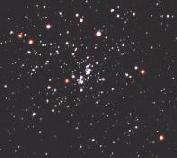Clusters (original) (raw)
STAR CLUSTERS
Open clusters are found in the disk of the Galaxy, and therefore lie largely in the plane of the Milky Way. Many of the closer ones, including those presented here, are easily visible to the naked eye (Messier 35 a fainter exception). Some are angularly so large that they make constellations of their own, or at least significant parts of them.
Though their sizes vary greatly, open clusters typically contain a few hundred loosely arranged stars packed within a diameter 10 or so light years across. And though bound together by their own gravity (the false Coathanger below an exception), most open clusters gradually break up as a result of random encounters among stars that speed members to the escape velocity, and because of stretching by tides raised by the Galaxy. Following the set of naked-eye clusters is a link to a photo that shows the Hyades, Pleiades, and Messier 35 in context, as well as 15 fainter clusters near the Galaxy's anticenterin Taurus, [Auriga](auriga- p.html), Gemini, and Orion.
At the bottom are three contrasting globular clusters: Messier 13 in Hercules (which is also visible to the naked eye, though just barely), more massive but more distant (and thus visually fainter) Messier 15 in Pegasus, and less massive (and also fainter) Messier 10 in Ophiuchus. While there are thousands of open clusters in the Galaxy, there are but 150 or so known globulars. Distinct from open clusters, their home is in a huge spheroidal halo that surrounds the Galactic disk. And while open clusters are sparse, loose, and compartively young (the Alpha Persei cluster only 50 million years old, the Pleiades just 130 million), globulars are compact, closely spherical, and can contain over a million stars packed into a volume only a hundred or so light years across. With ages of 11 to 12 billion years, formed when the metal content of the Galaxy was much less than it is today (the increase the result of stellar evolution), they are among the oldest things known and among the first things to be created after the Big Bang, the event that formed our Universe.
Return to STARS.
Enjoy Poor Blue Straggler.
Open Clusters Visible to the Unaided Eye
| Alpha Persei | Beehive | Coathanger | Coma Berenices | Double Cluster |
|---|---|---|---|---|
| Hyades | Messier 6 | Messier 7 | Messier 35 | Pleiades |
| Ursa Major | 15 Fainter Clusters |
